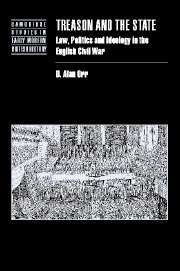1 - The statutory basis of English treason law
Published online by Cambridge University Press: 21 July 2009
Summary
On the eve of the English Civil War the statutory basis of English treason was fraught with ambiguity. This was the case even though in England, unlike France, statute had authoritatively defined the law of treason during the late medieval period. In the case of late-medieval France the law of treason developed from a combination of judicial practice and the study and exegesis of Roman law texts, most notably the Digest of Justinian. In England treason was set out in statutes – authoritative declarations of law enacted by king, lords and commons assembled in parliament. However, at the outbreak of the English Civil War the statutory basis of treason was not clearly established. How was this so? Confusion arose from two sources. First, it was unclear which statutes and which particular provisions contained in statutes were actually in force; second, even when there was agreement that a statute was in force, there were disputes over the meaning of the text. Medieval and Tudor statutes were often the product of particular political circumstances that no longer applied, yet early Stuart jurists were not averse to appropriating them to serve their arguments. Furthermore, the unscrupulous exploitation of textual ambiguities could give statutes a far more generous application than their framers had originally intended.
Since 1352 the English law of treason has been based on Edward III's statute of treasons (25 Edward III, st. 5, c. 2). Much of it is still in force.
- Type
- Chapter
- Information
- Treason and the StateLaw, Politics and Ideology in the English Civil War, pp. 11 - 29Publisher: Cambridge University PressPrint publication year: 2002



